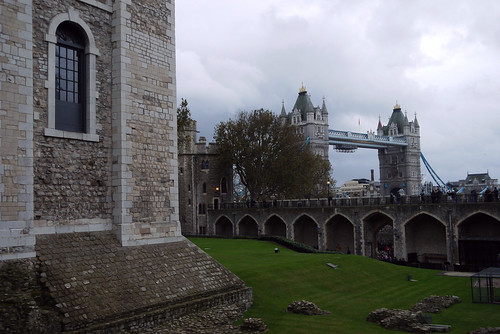Tower Bridge (built 1886–1894) is a combined bascule and suspension bridge in London which crosses the River Thames. It is close to the Tower of London, from which it takes its name, and has become an iconic symbol of London.
The bridge consists of two bridge towers tied together at the upper level by means of two horizontal walkways, designed to withstand the horizontal forces exerted by the suspended sections of the bridge on the landward sides of the towers. The vertical component of the forces in the suspended sections and the vertical reactions of the two walkways are carried by the two robust towers. The bascule pivots and operating machinery are housed in the base of each tower.
A huge challenge faced the City of London Corporation – how to build a bridge downstream from London Bridge without disrupting river traffic activities. To generate ideas, the “Special Bridge or Subway Committee” was formed in 1876, and opened the design for the new crossing to public competition.
Over 50 designs were submitted for consideration, some of which are on display at Tower Bridge Exhibition. It wasn’t until October 1884 however, that Horace Jones, the City Architect, in collaboration with John Wolfe Barry, offered the chosen design for Tower Bridge as a solution.
It took eight years, five major contractors and the relentless labour of 432 construction workers to build Tower Bridge.
Two massive piers were sunk into the river bed to support the construction and over 11,000 tons of steel provided the framework for the Towers and Walkways. This framework was clad in Cornish granite and Portland stone to protect the underlying steelwork and to give the Bridge a more pleasing appearance.
When it was built, Tower Bridge was the largest and most sophisticated bascule bridge ever completed (“bascule” comes from the French for “see-saw”). These bascules were operated by hydraulics, using steam to power the enormous pumping engines. The energy created was stored in six massive accumulators, as soon as power was required to lift the Bridge, it was always readily available. The accumulators fed the driving engines, which drove the bascules up and down. Despite the complexity of the system, the bascules only took about a minute to raise to their maximum angle of 86 degrees.
Today, the bascules are still operated by hydraulic power, but since 1976 they have been driven by oil and electricity rather than steam. The original pumping engines, accumulators and boilers are now exhibits within Tower Bridge Exhibition’s Engine Rooms.











Oh, Tower Bridge. Long time ago, that I have sean it – 2002!! Thank you for showing.
Sigrun
I love the view of Tower Bridge from the Tower of London
They built a new glass floor on the walkway connecting the two towers last November.
I went to see it last December, the views from above were thrilling!
I have not been in Tower Bridge… Yet
This bridge is iconic…and I have seen many programs about it….fascinating. I really can’t wait to see it in person someday!
I hope you get the opportunity to visit
interesting text and great shots to go along with it, CP. i enjoyed this post thoroughly
Thanks Ayush
This might be difficult to understand but in a different life back in 2006, 7 or 8, I was given a Christmas present of a trip to London on the train from Bristol. We saw a matinee performance of Stomp in a Strand theatre and did the Tower Bridge experience including a guided tour and a walk across the top in between the two towers. Awesome experience that I was looking forward to seeing i missed it on my numerous charter rail trips back in the 90s.
Despite many visits to London I have never done the guided tour or walk between the two towers. I can imagine it must be spectacular